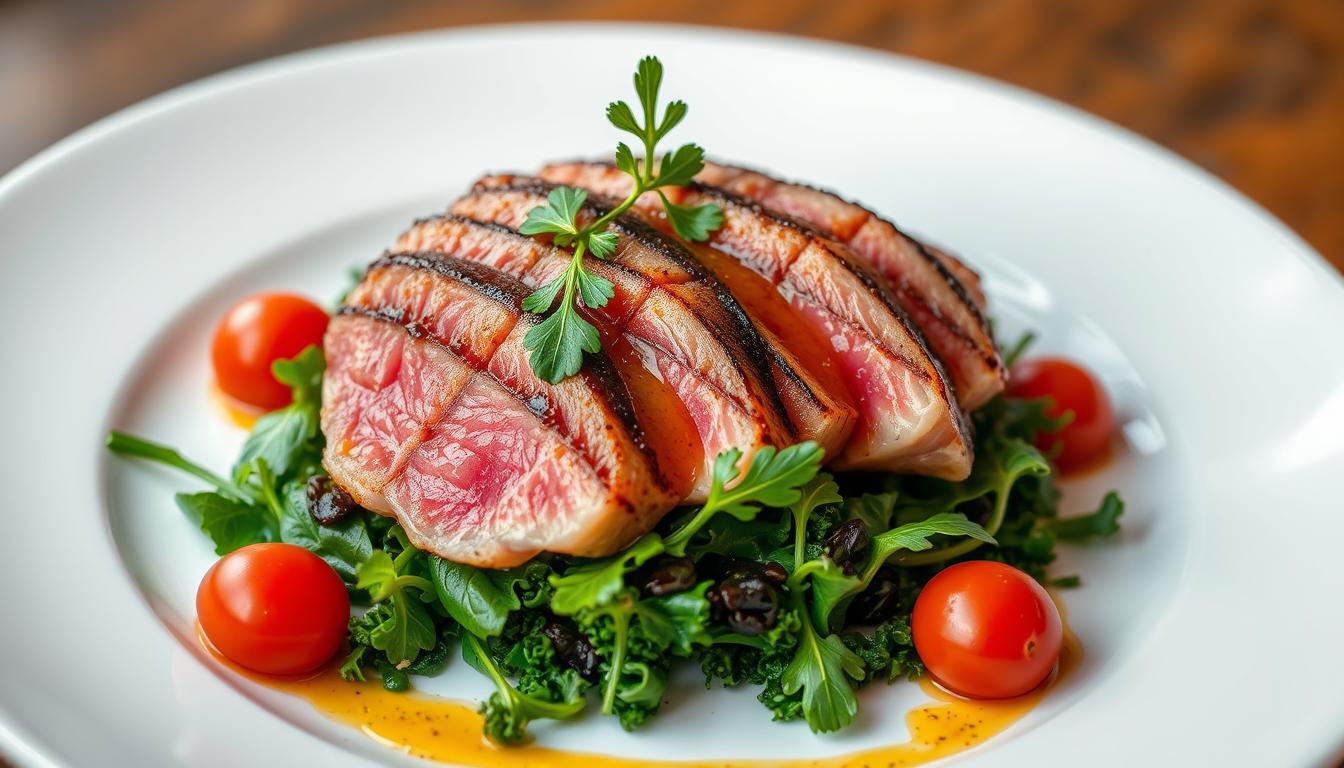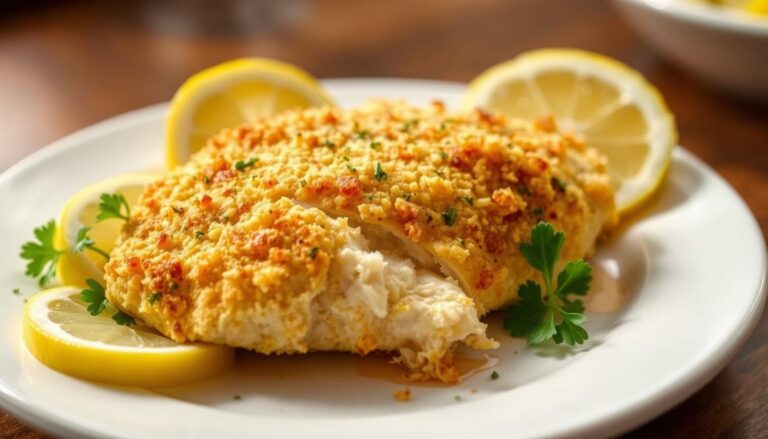Ahi Tuna Recipe – Healthy and Flavorful
The first time I found out about ahi tuna, it was like discovering a secret in cooking. This vibrant, ruby-red fish is not just beautiful—it’s also full of nutrients. It can make your cooking at home amazing.
If you love seafood or want to eat healthier, ahi tuna is perfect. It’s a mix of great taste and health benefits. Ahi tuna is loved in sushi places and home kitchens alike.
Start your ahi tuna recipe adventure here. You’ll find a dish that’s tasty and full of nutrients for your health.
Table of Contents
Understanding Ahi Tuna: Types and Selection
Dive into the world of ahi tuna, a prized fish that brings exceptional flavor to yellowfin tuna dishes and tuna sashimi. Ahi tuna includes two distinct tropical fish species. Seafood lovers and chefs cherish them for their unique characteristics and culinary versatility.
Yellowfin vs Bigeye Tuna
When exploring ahi tuna, you’ll find two main varieties: yellowfin and bigeye. Each type has its own qualities that affect your cooking experience:
- Yellowfin tuna: Lighter meat with a mild flavor
- Bigeye tuna: Richer, more intense taste profile
| Characteristic | Yellowfin Tuna | Bigeye Tuna |
|---|---|---|
| Color | Bright pink to red | Deep red |
| Fat Content | Lower | Higher |
| Best For | Seared dishes | Raw preparations |
How to Choose Fresh Ahi Tuna
Selecting premium ahi tuna requires careful observation. Look for these key indicators when picking fish for your tuna sashimi or yellowfin tuna dishes:
- Bright, vibrant color without brown edges
- Firm texture with no soft spots
- Clean, ocean-like smell
- Minimal liquid in packaging
Sushi-Grade vs Regular Tuna
Not all tuna is created equal. Sushi-grade tuna is handled specially to ensure it’s safe for raw consumption. Regular tuna needs thorough cooking to avoid health risks. Always choose sushi-grade varieties for tuna sashimi from reputable sources.
Essential Ingredients and Equipment
Creating tasty ahi tuna recipes needs the right ingredients and tools. Whether you’re making a seared dish or raw tuna, the right equipment is key. It helps you make meals as good as those in restaurants.
Key Ingredients for Ahi Tuna
- Fresh sushi-grade ahi tuna
- High-quality soy sauce
- Sesame oil
- Fresh ginger
- Garlic
- Green onions
- Sesame seeds
Choose fresh and high-quality ingredients for your ahi tuna. Sushi-grade tuna is best for flavor and safety. The right mix of Asian seasonings will make your dish stand out.
Essential Cooking Equipment
- Sharp chef’s knife for precise cutting
- Cast iron skillet or heavy-bottomed pan
- Tongs
- Cutting board
- Meat thermometer
- Mixing bowls
The right tools are vital for cooking perfect ahi tuna. A cast iron skillet is great for a seared exterior and a rare center. Sharp knives are crucial for clean cuts, especially in raw tuna recipes.
Pro tip: Always pat your ahi tuna dry before cooking to achieve the perfect sear and prevent steaming.
Perfect Marinade Components
Making a great ahi tuna recipe begins with a perfect marinade. It boosts the fish’s natural taste. The right mix of ingredients turns your Hawaiian tuna recipes into something special. Each bite becomes full of flavor and character.
Base Ingredients That Make a Difference
Your marinade needs key parts to balance taste and make the tuna tender. Here are the essential base ingredients:
- High-quality soy sauce
- Sesame oil
- Fresh citrus juice (lemon or lime)
- Natural sweetener (honey or maple syrup)
Asian-Inspired Flavor Profiles
Add vibrant Asian flavors to your ahi tuna recipe:
- Ginger: Adds a zesty, warming note
- Garlic: Provides robust depth
- Rice vinegar: Introduces subtle tanginess
- Sriracha or chili paste: Brings gentle heat
Marinade Timing Guidelines
Timing is key when marinating ahi tuna. Fish needs a gentle touch to keep its tender texture. Aim for a short marination:
- 15-30 minutes maximum for optimal flavor
- Refrigerate during marination
- Avoid acidic marinades longer than 30 minutes
Mastering these marinade techniques will make your Hawaiian tuna recipes burst with island flavors. They’ll be as good as those in a restaurant.
Ahi Tuna Recipe – Seared

Making the perfect seared ahi tuna recipe needs precision and a few key techniques. You want a golden-brown crust and a rare, vibrant center that’s tender.
To start your ahi tuna recipe seared to perfection, you’ll need a few essential ingredients:
- Fresh sushi-grade ahi tuna steaks
- High-heat cooking oil (like avocado or grapeseed)
- Kosher salt
- Freshly ground black pepper
- Optional sesame seeds for coating
The secret to an exceptional seared ahi tuna recipe is high heat and quick cooking. Aim to sear each side for just 1-2 minutes. This method gives you a crispy exterior and a rare, tender inside.
Here’s how to prepare your seared ahi tuna:
- Pat the tuna steaks completely dry with paper towels
- Season generously with salt and pepper
- Heat a cast-iron skillet or heavy-bottom pan until smoking hot
- Add a thin layer of high-heat oil
- Carefully place tuna steaks in the pan
- Sear for 60-90 seconds on each side
- Remove immediately and let rest for 2-3 minutes
For an extra flavor boost, coat your tuna with sesame seeds before searing. This adds a delightful crunch and nutty flavor to your ahi tuna recipe seared to restaurant-quality perfection.
Preparation Techniques and Tips
Preparing ahi tuna needs careful attention to keep its quality and flavor top-notch. Whether you’re making a raw tuna dish or searing it, knowing the right steps is key. This ensures both great taste and safety.
Success with ahi tuna recipes begins with understanding key preparation steps. The right approach can turn your seafood into something truly special.
Proper Thawing Methods
Thawing ahi tuna correctly is vital to keep its delicate texture and prevent bacterial growth. Here are the safest ways to thaw:
- Refrigerator thawing: Place frozen tuna in the fridge overnight
- Cold water method: Submerge sealed tuna in cool running water
- Avoid thawing at room temperature to prevent bacterial contamination
Temperature Guidelines
Temperature control is crucial when preparing raw tuna. Follow these guidelines:
- Keep raw ahi tuna below 40°F during storage
- Use a food thermometer to check temperatures
- Eat raw tuna right after preparing it
Cutting and Handling Techniques
Precise cutting is essential for the best presentation and texture in your ahi tuna recipe. Here are some professional tips:
- Use a sharp, clean knife for precise cuts
- Cut against the grain for tender pieces
- Slice thinly for sashimi or poke bowls
- Clean cutting surfaces thoroughly between uses
Mastering these preparation techniques will take your raw tuna recipes from basic to restaurant-quality. You’ll ensure both safety and amazing flavor.
Cooking Methods and Temperature Control

Cooking yellowfin tuna right needs precision and knowing how to manage heat. To get your ahi tuna seared just right, pick the best cooking method and keep the temperature in check.
There are many ways to cook ahi tuna, each with its own special touch. You can try different methods to find the flavor and texture you like best.
- Searing: Quick, high-heat method for crispy exterior
- Grilling: Adds smoky flavor to yellowfin tuna dishes
- Broiling: Intense heat for quick cooking
- Poaching: Gentle technique for delicate texture
Keeping the temperature right is key when cooking ahi tuna. You want to keep the fish tender while getting it cooked just the way you like it.
| Cooking Method | Cooking Time | Doneness Level |
|---|---|---|
| Searing | 2-3 minutes per side | Rare to Medium-Rare |
| Grilling | 3-4 minutes total | Medium |
| Broiling | 4-5 minutes | Medium-Well |
Your perfect ahi tuna dish should be cooked quickly. Overcooking ruins the delicate taste and makes the fish tough. You want a pink center to show off the tuna’s quality.
Pro tip: Use a meat thermometer to ensure perfect doneness every time!
Healthy Benefits and Nutritional Value
Healthy ahi tuna is a nutritional powerhouse that can boost your diet. It’s packed with nutrients that support your overall health. Plus, it tastes great, making it a delicious way to nourish your body.
The nutritional profile of healthy ahi tuna is impressive. It’s a favorite among health-conscious food lovers. This fish is full of essential nutrients that boost your health and energy.
Protein Content and Omega-3s
Ahi tuna is a great source of protein, perfect for those looking for lean options. Each serving offers:
- Approximately 25 grams of protein per 3-ounce serving
- High-quality complete protein with all essential amino acids
- Low-calorie protein option for muscle maintenance
“Omega-3 fatty acids in ahi tuna are crucial for heart and brain health, offering natural protection against inflammation.” – Nutrition Experts
Vitamins and Minerals
Healthy ahi tuna is more than just protein. It’s also rich in vitamins and minerals that support your body’s functions:
- Selenium: Supports thyroid function and immune health
- Vitamin B12: Enhances neurological function
- Potassium: Promotes heart and muscle health
- Vitamin D: Supports bone strength and immune system
Dietary Considerations
For those on a diet, healthy ahi tuna is a great choice. It’s low in fat and high in nutrients. It fits well into various diets, including:
- Keto diets
- High-protein meal plans
- Heart-healthy nutrition strategies
- Weight management programs
Pro tip: Choose sushi-grade ahi tuna to maximize nutritional benefits and ensure the highest quality protein source.
Serving Suggestions and Pairings
Want to impress your guests? Try serving ahi tuna in new and exciting ways. From colorful poke bowls to fancy tuna tartare, this fish is perfect for any meal.
Poke bowls are a great way to show off ahi tuna’s taste. Start with rice or quinoa, then add fresh tuna, veggies, and zesty sauces. The goal is to mix textures and tastes that match the fish’s rich flavor.
- Tuna tartare: A sophisticated appetizer that highlights the fish’s delicate texture
- Tuna ceviche: A refreshing option perfect for warm summer days
- Asian-inspired salads with thin-sliced raw ahi
When it comes to wine, choose crisp whites or light reds. They won’t overwhelm the tuna’s taste. Sauvignon Blanc and Pinot Noir pair well with tuna dishes.
Pro tip: Always use sushi-grade ahi tuna when preparing raw dishes to ensure food safety and optimal taste.
Make your tuna ceviche a hit by adding fresh citrus, cilantro, and a bit of chili. These ingredients bring out the fish’s natural taste and make for a memorable meal.
Storage and Food Safety Guidelines
Proper storage is key when making raw tuna recipes or ahi poke. Your safety depends on how you handle and store fresh ahi tuna. This helps prevent bacterial growth and keeps the tuna fresh.
Here are the essential steps for storing seared or raw ahi tuna:
- Refrigerate ahi tuna right after you prepare it
- Put it in an airtight container
- Keep it at or below 40°F (4°C)
- Eat it within 24 hours for the best taste
Raw tuna recipes need extra care. Sushi-grade tuna must stay very cold to avoid bacteria. Always use clean tools and surfaces when handling raw fish to prevent contamination.
Watch out for these signs that your ahi tuna might be spoiled:
- Unusual fishy smell
- Change in color
- Slime on the surface
- Dull or grayish look
If you want to store ahi tuna for longer, you can freeze it. Wrap it well in plastic wrap and put it in a freezer-safe bag. Frozen ahi tuna can last up to 2-3 months if stored at 0°F (-18°C).
Pro tip: Always thaw frozen ahi tuna in the fridge, not at room temperature.
By sticking to these storage and safety tips, your ahi poke and raw tuna recipes will stay tasty and safe to eat.
Conclusion
Exploring ahi tuna recipes is a vibrant culinary journey. It combines great flavor with health benefits. This is just the start of finding tasty and healthy meals to add to your cooking.
A healthy ahi tuna dish is more than a meal. It’s a way to learn about sustainable seafood and nutrition. By learning different cooking methods, you’ll get the most out of this amazing protein. It offers strong flavor and important nutrients in every bite.
Whether you’re an experienced cook or just starting, this guide helps you make top-notch dishes at home. Try out different marinades and cooking methods. Most importantly, enjoy making delicious meals that are good for you.
Your cooking skills will keep improving as you practice with ahi tuna. Remember, cooking is an art. Be creative, trust your instincts, and enjoy every moment of cooking.







